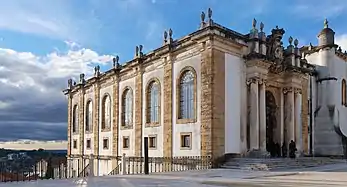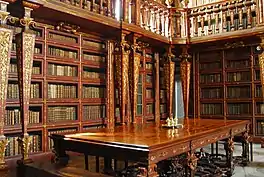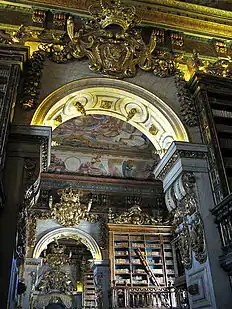Biblioteca Joanina
The Johannine Library (Portuguese: Biblioteca Joanina) is a Baroque library situated in the heights of the historic centre of the University of Coimbra, by the university tower. in the civil parish of Coimbra (Sé Nova, Santa Cruz, Almedina e São Bartolomeu), municipality of Coimbra, district of the same name.


Built in the 18th century during the reign of the Portuguese King John V, it is part of the University of Coimbra General Library. It is a National Monument and has a priceless historical value being one of the main tourist attractions among the older monuments belonging to the university.
History
The Casa da Livraria (House of the Library), the name that it was known, received its first books in 1750, its construction completed between 1717 and 1728.[1]
Architecture

Over the entrance door, the library exhibits the national coat of arms. Inside, there are three great rooms divided by decorated arches, bearing the same style as the portal and entirely executed by Portuguese artists. The walls are covered by two storied shelves, in gilded or painted exotic woods; the painted ceilings, by the Lisbon artists Simões Ribeiro and Vicente Nunes, blend harmoniously with the rest of the decoration.
The building has three floors and shelters about 200000 volumes, of which 40000 are located on the first floor.[1] These bibliographic collections can be consulted, by request, with justification and motives for the need to consultation.[1] Upon approval, the referenced work is taken to the Biblioteca Geral by functionary, where the document can be examined.[1] The care taken in this respect is a direct consequence of the rarity and age of the documents in the library; the collection date from the 16th, 17th and 18th centuries, whose majority represent the best works from Europe at the time.[1] The library contains about 250 thousand volumes, namely works of medicine, geography, history, humanistic studies, science, civil and canon law, philosophy and theology.
All the bibliographic works are in the best condition since the building is a perfect vault, with a stable environment, throughout the year, from summer to winter.[1] The building was conceived as a library house constructed with exterior walls around 2.11 metres (83 in) thick. The door of the "vault" is constructed of teak, that permits the space maintain a constant temperature of 18–20 °C (64–68 °F).[1] To maintain this stable environment the humidity hovers around 60%, thereby conditioning the wood interior. In addition to issues of humidity and temperature, the stacks are affected by another "enemy": papirófagos, insects that survive on paper.[1] But, the structure is protected by being constructed of oak woods, that, in addition to its dense nature (which makes it difficult for wood penetration, elicits an odor that is repellent to these insects.[1]
Bats
The library is noted as being one of two in the world (the Mafra palace library being the other) whose books are protected from insects by the presence of a colony of bats within the library.[2] During the night, the bats consume the insects that appear, eliminating the pest and assisting the maintenance of the stacks.[3][4] Each night, workers cover the "bufets" (credenzas) with sheets of leather. In the morning the library is cleaned of bat guano.[2]
References
Notes
- University of Coimbra (2009), p.1
- Kowsmann, Patricia (17 June 2018). "The Bats Help Preserve Old Books But They Drive Librarians, Well, Batty" – via www.wsj.com.
- "Bats eat bookworms".
- Nuwer, Rachel. "Bats Act As Pest Control at Two Old Portuguese Libraries".
Sources
- UC, ed. (2009), Biblioteca Joanina (in Portuguese), Coimbra, Portugal: University of Coimbra
